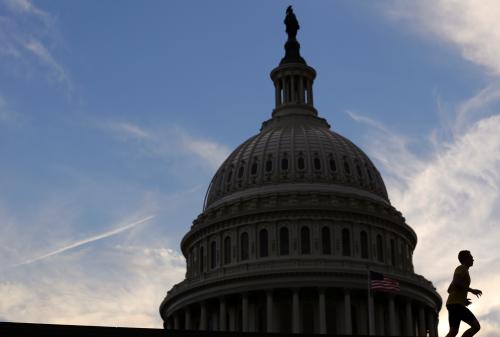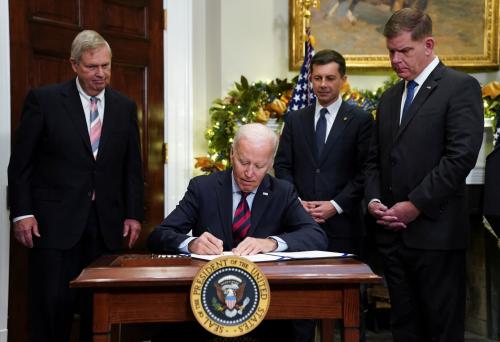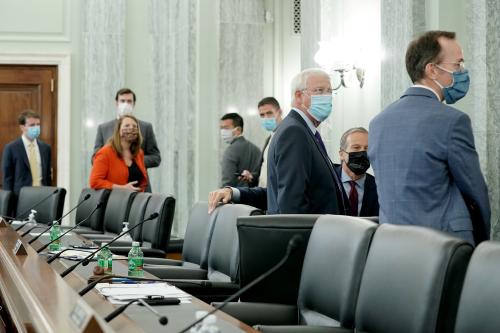This post will be updated as design changes to the Tracker are made.
The Brookings Deregulatory Tracker (Reg Tracker) is a tool that tracks and provides insights into deregulatory actions under the Trump administration. Launched in October 2017, the Reg Tracker monitors a curated selection of delayed, repealed, and new rules, notable guidance and policy revocations, and important court battles. The rules span a wide range of policy areas, including but not limited to education, finance, environment, and transportation.
This post provides context surrounding the regulatory process, details on what actions the Reg Tracker includes, and guidance on how to use its interactive features.
What inspired the Reg Tracker?
President Trump committed to a deregulatory agenda. In his first week in office, he issued Executive Order 13771 (E.O. 13771): “Reducing Regulation and Controlling Regulatory Costs.” E.O. 13771 requires that “for every new regulation issued, at least two prior regulations be identified for elimination, and that the cost of planned regulations be prudently managed and controlled through a budgeting process.” Several actions in the Reg Tracker are in response to this order.
The tracker helps assess the extent to which the Trump administration is deregulating as intended through its regulatory agenda and subsequent actions.
What actions are included in the Reg Tracker?
Federal agencies are extensions of the executive branch, and have the ability to make, interpret, and enforce rules and regulations. Federal rulemaking is governed, in large part, by the Administrative Procedure Act (APA). The process of issuing (or removing) regulations can be a long and arduous one. After a rule is “proposed”, it must undergo a notice-and-comment period before it becomes “final” and “effective.” All proposed and final rules are required to be published in the Federal Register (FR). Each regulation in the Reg Tracker has a timeline that monitors that entry’s status in the process. Hover over the question mark to view a key.
While we tend to focus on the rulemaking process, the Reg Tracker also includes some deregulatory actions that don’t proceed through notice and comment. For instance, it includes guidance revocations and executive actions that have immediate, unmistakably “deregulatory” impact (e.g. Trump’s Executive Order 13783 withdrawing the technical documents for the social cost of carbon). It also includes rules that were rescinded through use of the Congressional Review Act (CRA), which creates a procedure for Congress to disapprove and thus nullify regulations that are promulgated by federal agencies. All rules must be reported to Congress, and upon receiving the report, CRA gives Congress 60 legislative working days to introduce a special joint resolution or disapproval of the rule. Historically, the CRA was used to reverse only one rule in its first 20 years in existence, but the Trump administration has used it several times.[1] Actions that do not proceed through notice and comment will often have a descriptive box in place of the usual timeline.
How are entries chosen?
A team of Brookings staff scans every issue of the FR for items that are deregulatory in nature, such as effective date delays of Obama-era rules, final rule withdrawals, and proposals to withdraw or rework old regulations. We exclude withdrawals of proposed rules.
Additionally, the team scans major and specialty news sources, as well as major court proceedings (notably in the D.C. Circuit) for events like court decisions or legal injunctions. Actions that are newsworthy or are consistent with Trump’s deregulatory agenda are included in the Reg Tracker.
Does the Reg Tracker include all deregulations?
Given the vastness of the regulatory sphere, this tool is not intended to be comprehensive and does not include every single deregulatory action made by the Trump administration. It also does not provide cost estimates of new or proposed rules, nor does it include actions like selective enforcement and budget reprogramming, even though they can be deregulatory in nature. Items that are arcane, routine, or uncontroversial are usually excluded. Instead, the Reg Tracker is intended to provide a cultivated list of economically or politically significant, controversial, or otherwise newsworthy regulatory events.
How often is the Reg Tracker updated?
The Reg Tracker undergoes an update approximately every week to reflect new deregulatory actions or to provide any new updates on existing actions (note: not every entry is updated weekly, and only those entries with any new actions are updated). Each entry has a “last updated” date that appears next to its heading, which indicates when that particular entry was last changed by the staff (i.e. many entries have been reviewed by staff later than the “last updated” date, but no further regulatory actions took place with regards to that entry).
How are the entries sorted?
New entries (entries that were changed within the last 14 days) will appear at the top, and will be indicated by a yellow “New” tag. By default, older entries will be sorted by the “last updated” date. Entries can also be sorted by name, category, agency or status by clicking on the respective headings.
Can I filter entries based on certain criteria?
Users may choose to view only entries in a particular category (e.g. environmental, education, etc.), with a certain status (e.g. in rulemaking, effective, etc.), or by the rule’s “noteworthiness ” (see next question).
What entries are deemed “Noteworthy”?
Since the tracker is comprised of a long list of entries that is consistently growing, we mark certain entries as “noteworthy,” for those looking to focus on a few important deregulations. These “noteworthy” regulations are those that have a particularly significant impact and are at the forefront of President Trump’s deregulatory agenda. These entries can be found by checking the “Noteworthy only” box in the selection bar.
Sign up here to subscribe to the Reg Center newsletter, which will include updates to the Reg Tracker.
If you have questions, suggestions or feedback, we would love to hear from you! Email us at [email protected].
[1] Joint resolutions of disapproval that are passed under the CRA must be signed by the president to become law. Thus, the president’s opinion on the regulation in question largely determines whether it is reversed under the CRA.








Commentary
Explaining the Brookings Deregulatory Tracker
October 18, 2018